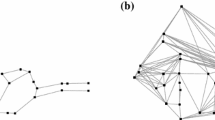Abstract
One quarter of Europe’s energy demand is provided by natural gas distributed through a vast pipeline network covering the whole of Europe. At a cost of 1 million Euro per km extending the European pipeline network is already a multi-billion Euro business. Therefore, automatic planning tools that support the decision process are desired. Unfortunately, current mathematical methods are not capable of solving the arising network design problems due to their size and complexity. In this article, we will show how to apply optimization methods that can converge to a proven global optimal solution. By introducing a new class of valid inequalities that improve the relaxation of our mixed-integer nonlinear programming model, we are able to speed up the necessary computations substantially.




Similar content being viewed by others
References
Achterberg T (2009) SCIP: solving constraint integer programs. Math Program Comput 1(1):1–41
André J, Bonnans JF (2008) Optimal features of gas transmission trunklines. In Eng Opt 2008 - International Conference on Engineering Optimization, 2008. Rio de Janeiro, Brazil
Berthold T, Heinz S, Vigerske S (2012) Extending a CIP framework to solve MIQCPs. In Lee J, Leyffer S (eds), Mixed integer nonlinear programming, vol 154. Part 6 of the IMA volumes in mathematics and its applications, pp 427–444. Springer. Also available as ZIB-Report 09–23
Bonnans JF, André J (2009) Optimal structure of gas transmission trunklines. Technical Report 6791, Institut National de Recherche en Informatique et en Automatique
Boyd ID, Surry PD, Radcliffe NJ (1994) Constrained gas network pipe sizing with genetic algorithms. Technical Report EPCC-TR94-11, Edinburgh Parallel Computing Centre
Boyd S, Vandenberghe L (2004) Convex optimization. Cambridge University Press
Bundesanstalt für Geowissenschaften und Rohstoffe (2013) Energiestudie 2013 - Reserven, Ressourcen und Verfügbarkeit von Energierohstoffen, 2013. Downloaded on August 26, 2014
Castillo L, Gonzáleza A (1998) Distribution network optimization: finding the most economic solution by using genetic algorithms. Eur J Oper Res 108(3):527–537
Cerbe G (2008) Grundlagen der Gastechnik: Gasbeschaffung - Gasverteilung - Gasverwendung. Hanser, Leipzig
CPLEX (2011) User’s Manual for CPLEX. IBM Corporation, Armonk, USA, 12.1 edn
De Wolf D, Bakhouya B (2008) Optimal dimensioning of pipe networks: the new situation when the distribution and the transportation functions are disconnected. Technical Report 07/02, Ieseg, Université catholique de Lille, HEC Ecole de Gestion de l’ULG
De Wolf D, Smeers Y (1996) Optimal dimensioning of pipe networks with application to gas transmission networks. Oper Res 44(4):596–608
De Wolf D, Smeers Y (2000) The gas transmission problem solved by an extension of the simplex algorithm. Manag Sci 46(11):1454–1465
Fügenschuh A, Geißler B, Gollmer R, Morsi A, Pfetsch ME, Rövekamp J, Schmidt M, Spreckelsen K, Steinbach MC (2014) Physical and technical fundamentals of gas networks. In Koch T, Hiller B, Pfetsch ME, Schewe L (eds) Evaluating gas network capacities, MOS-SIAM Series on Optimization, chapter 2. SIAM (To appear)
GAMS Model Library (2013). General algebraic modeling system (GAMS) model library. Information available at URL. http://www.gams.com/modlib/modlib.htm
Geißler B, Martin A, Morsi A (2013) LaMaTTO++. Information available at URL. http://www.mso.math.fau.de/edom/projects/lamatto.html
Humpola J (2014) Gas network optimization by MINLP. PhD thesis, Technical University Berlin
Humpola J, Fügenschuh A (2013) A unified view on relaxations for a nonlinear network flow problem. ZIB-Report 13–31, Zuse Institute Berlin, Takustr. 7, 14195 Berlin, Germany
Humpola J, Fügenschuh A, Lehmann T (2014) A primal heuristic for optimizing the topology of gas networks based on dual information. EURO J Comput Optim pp 1–26
Korte B, Vygen J (2007) Combinatorial optimization: theory and algorithms. Springer, Berlin
Mariani O, Ancillai F, Donati E (1997) Design of a gas pipeline: optimal configuration. Technical report PSIG 9706, Pipeline Simulation Interest Group
Nemhauser GL, Wolsey LA (1988) Integer and combinatorial optimization. Wiley, New York
O’Neill RP, Williard M, Wilkins B, Pike R (1979) A mathematical programming model for allocation of natural gas. Oper Res 27(5):857–873
Osiadacz AJ, Górecki M (1995) Optimization of pipe sizes for distribution gas network design. Technical Report PSIG 9511, Pipeline Simulation Interest Group
Pfetsch ME, Fügenschuh A, Geißler B, Geißler N, Gollmer R, Hiller B, Humpola J, Koch T, Lehmann T, Martin A, Morsi A, Rövekamp J, Schewe L, Schmidt M, Schultz R, Schwarz R, Schweiger J, Stangl C, Steinbach MC, Vigerske S, Willert BM (2014) Validation of nominations in gas network optimization: Models, methods, and solutions. Optimization Methods and Software
Schroeder DW (2001) A tutorial on pipe flow equations. Technical Report PSIG 0112, Pipeline Simulation Interest Group
SCIP: solving constraint integer programs (2013) URL. http://scip.zib.de/
Smith EMB, Pantelides CC (1999) A symbolic reformulation/spatial branch-and-bound algorithm for the global optimization of nonconvex MINLPs. Comp Chem Eng 23:457–478
Tawarmalani M, Sahinidis NV (2004) Global optimization of mixed-integer nonlinear programs: a theoretical and computational study. Math Program 99(3):563–591
Tawarmalani M, Sahinidis NV (2005) A polyhedral branch-and-cut approach to global optimization. Math Program 103(2):225–249
Vereinigung der Fernleitungsnetzbetreiber Gas e. V. Netzentwicklungsplan gas (2013) Konsultationsdokument der deutschen Fernleitungsnetzbetreiber. Downloaded on August 26, 2014
Vigerske S (2012) Decomposition in multistage stochastic programming and a constraint integer programming approach to mixed-integer nonlinear programming. PhD thesis, Humboldt-Universität zu Berlin
Wächter A, Biegler LT (2006) On the implementation of a primal-dual interior point filter line search algorithm for large-scale nonlinear programming. Math Program 106(1):25–57
Weymouth TR (1912) Problems in natural gas engineering. Trans Am Soc Mech Eng 34(1349):185–231
Acknowledgments
We are grateful to Open Grid Europe GmbH (OGE, Essen/Germany) and all members of the Forschungskooperation Netzoptimierung (ForNe) for supporting our work. Coauthor Armin Fügenschuh conducted parts of this research under a Konrad Zuse Junior Fellowship. Parts of this research have been supported by the German Ministry for Economic Affairs and Energy. We thank two anonymous referees for carefully reading our manuscript and their various comments helping us to improve its quality.
Author information
Authors and Affiliations
Corresponding author
Rights and permissions
About this article
Cite this article
Humpola, J., Fügenschuh, A. & Koch, T. Valid inequalities for the topology optimization problem in gas network design. OR Spectrum 38, 597–631 (2016). https://doi.org/10.1007/s00291-015-0390-2
Received:
Accepted:
Published:
Issue Date:
DOI: https://doi.org/10.1007/s00291-015-0390-2




